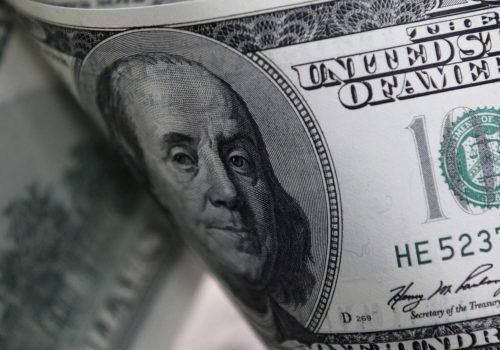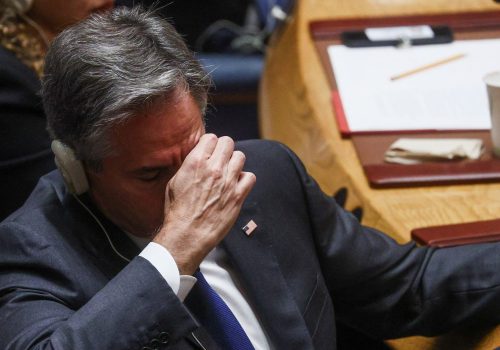Since Russia launched its war on Ukraine, the United States and Europe have moved in close coordination to impose sanctions and reduce their economic dependency on the aggressor. There has also been more momentum behind developing a collective long-term strategy to defend the economic order from an attack on the basic principles of sovereignty and freedom.
The transatlantic economic response to Russian aggression will be front and center on Wednesday as the Atlantic Council’s GeoEconomics Center and German think tank Atlantik-Brücke join forces to hold the first annual forum on US-EU GeoEconomics in Frankfurt, a crucial hub for transatlantic and global trade. Featuring appearances by European Central Bank President Christine Lagarde and European Union (EU) Commissioner for Economy Paolo Gentiloni, the day-long forum is bringing together leaders from government, business, and academia to inspire cooperation on the hottest economic debates from trade and sanctions to data and digital currencies.
The importance of closer partnership in these critical areas is a theme across four in-depth reports prepared by GeoEconomics Center experts ahead of the forum. Here’s a breakdown of the top takeaways from this research, and how it plays into the defense of shared economic principles.
Preserving economic statecraft tools
The measures taken in response to Russia’s aggression were decided quickly and out of necessity to swiftly respond to the invasion. Now is the time to ensure that competitors’ fledgling efforts to diversify away from Western currency reserves do not blunt US and European economic statecraft tools.
In her paper, Carla Norloff shows that non-aligned international economies are clearly attempting to diversify their portfolio of reserves away from dollars and into Chinese yuan and other currencies in the wake of the Group of Seven (G7) sanctions regime against Russia.
While the chart shows a net increase in yuan-denominated reserves since February, the crucial point is that there is a long way to go before the dollar and the euro’s global dominance is affected.
Meanwhile, Martin Mühleisen argues that the dollar-based monetary system has withstood the major tests of the past two years remarkably well. As global economic activity has been shifting east, it remains unlikely for the yuan to replace the dollar and the euro, in part because a larger global role for the Chinese currency would be inconsistent with Beijing’s current policy priorities: a closed current account placing restrictions on capital flows (especially outward) and carefully managed exchange rates.
However, there is no room for complacency. The United States and Europe can use economic statecraft tools without forgoing influence in the long term—on the condition that they keep their economic houses in order and allies close.
Rising to the challenge on trade
The United States and the EU have come a long way since the trade spats that characterized the Donald Trump presidency. Having resolved longstanding disputes over aircraft subsidies, steel, and aluminum (albeit in some cases temporarily), both sides are now enthusiastically engaging in promising discussions on supply-chain resilience and regulatory coordination in new sectors of the economy within the EU-US Trade and Technology Council (TTC).
The United States is trying the same “beyond-the-border,” regulation-focused approach with the Indo-Pacific Economic Framework (IPEF). The Biden administration’s approach assiduously avoids elements contained in traditional free trade agreements (FTAs), such as the pursuit of new market access in the form of tariff reduction. The EU has maintained the more traditional approach of pushing bilateral FTAs with economies throughout the region, and with some success.
New research by Clete Willems and Niels Graham argues that the Biden administration will struggle to link supply chains with partners and allies unless the United States re-opens negotiations on market access. And even if the administration is not willing to do so now, it should include design features in IPEF and the TTC that enable them to serve as stepping stones to true FTAs with market access in the future.
New digital-currency frontiers
As a growing number of countries explore domestic Central Bank Digital Currencies (CBDCs), multi-country cross-border CBDC pilots are also proliferating. These CBDCs could make cross-border payments faster, cheaper, and simpler. However, for any cross-border CBDC to unlock these benefits and be widely adopted, it must address concerns around privacy and data transparency.
Research by Giulia Fanti illustrates how various technical design choices can affect the privacy and transparency of cross-border CBDCs. The designs of these currencies are the result of policy choices taking into account tradeoffs regarding privacy, efficiency, and security. This requires coordination between different regulators and central banks.
Here, too, the United States and the EU should work together to create a regulatory environment to enable privacy-preserving cross-border CBDCs. Washington and Brussels should seize this opportunity to finally establish a transatlantic privacy framework and clarify how it can allow for the prevention of money laundering and terrorism financing.
Transatlantic work on CBDCs, just like on sanctions and trade, should harness the momentum behind immediate policy responses to major shocks in order to build a strategy for the medium to long term. This strategy must not ignore the very real challenges of inflation and low growth prospects; it must also build bridges with non-aligned economies, rather than forcing them to choose between China and the West.
This will be the great challenge for policymakers long after the Frankfurt Forum adjourns, at least for this year.
Charles Lichfield is the deputy director of the GeoEconomics Center.
Further reading
Thu, Sep 22, 2022
The dollar has some would-be rivals. Meet the challengers.
New Atlanticist By Ananya Kumar, Josh Lipsky
What are the realistic alternatives to the dollar that US and allied policymakers should be paying attention to? And how can they respond?
Thu, Sep 22, 2022
Multilateralism needs an overhaul. Here’s where to start.
New Atlanticist By Yomna Gaafar
The world is growing more volatile by the day—but leaders are acting within a system ill-equipped to handle the moment.
Mon, Sep 19, 2022
The 2022 Global Citizen Awards: Honoring the bridge-builders and peacemakers in a time of war
New Atlanticist By Katherine Walla, Daniel Malloy
The Atlantic Council's annual gala honored three world leaders, an Academy Award-winning artist, Google's CEO, and the strength of the transatlantic relationship.
Image: A passenger ship sails on the Main River in the morning, with the Frankfurt skyline and the European Central Bank in the background. Photo by Hannes P. Albert/dpa/REUTERS



